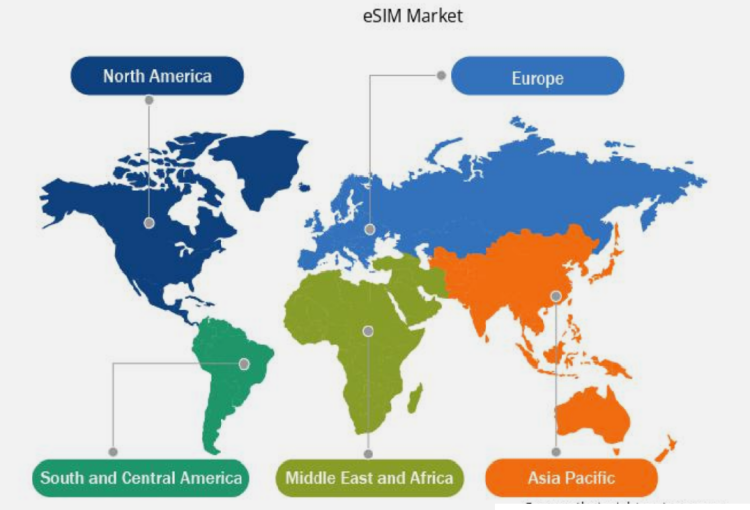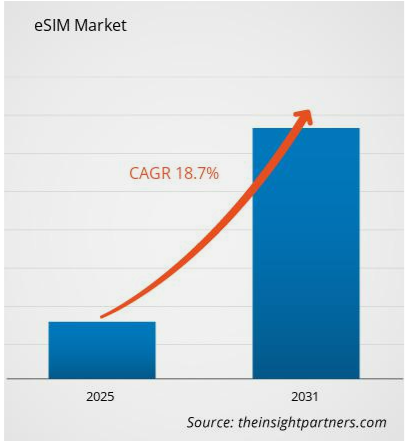Phone System Global™
Global Telecommunication & Technology company
Source: https://www.theinsightpartners.com/reports/esim-market

eSIM Market Analysis Source:
Rising adoption of smartphones and integration of eSIM in the automotive industry, as well as its cost-saving benefits, drive eSIM adoption. The increasing integration of eSIM technology in smartphones is propelling the global eSIM market growth. As leading smartphone manufacturers such as Apple, Samsung, and Google continue to embed eSIM functionality in their latest models, consumer awareness and adoption are rising significantly. This shift marks a departure from traditional SIM cards, offering enhanced flexibility, security, and a seamless user experience. 98% of all smartphone connections in North America will utilize eSIM technology by 2030, as per the estimated data by Telna, Inc. The first eSIM-enabled smartphone, the Google Pixel 2, was launched by Google in 2017. Google is consistently expanding eSIM support across its Pixel series, underscoring its strategic focus on advancing toward an eSIM-only future.
eSIM Market Overview
An embedded SIM (eSIM) is a next-generation digital SIM technology that eliminates the need for a physical SIM card. It is built directly into a device and allows users to download and activate mobile network profiles over the air. This innovation is transforming the telecommunications landscape by enabling greater flexibility, efficiency, and scalability. eSIM simplifies the activation process for end users, facilitates seamless switching between network providers, and supports multiple profiles on a single device. This is particularly valuable for frequent travelers, remote workers, and users of dual-SIM devices seeking cost-effective and uninterrupted connectivity without the hassle of swapping SIM cards. eSIM technology significantly enhances operational efficiency. It streamlines logistics by eliminating the need to distribute and manage physical SIM cards. It is ideal for managing large fleets of connected devices, including smartphones, tablets, wearables, and IoT hardware. Service providers benefit from reduced overhead, improved customer onboarding, and the ability to deliver more personalized, on-demand connectivity services.
eSIM Market: Strategic Insights
eSIM Market Drivers and Opportunities
Increasing Integration of eSIM in the Automotive Industry
eSIM technology is rapidly gaining traction within the automotive sector, offering significant advantages over traditional SIM cards. Unlike removable SIMs, eSIMs are embedded directly into vehicles, enabling remote provisioning and centralized connectivity management. This capability allows for continuous vehicle connectivity, supporting real-time traffic updates, navigation to nearby amenities, remote diagnostics, over-the-air (OTA) software updates, and access to emergency services, among others. For global automotive OEMs, automotive-grade eSIMs streamline manufacturing and supply chain processes. A standardized eSIM design can be integrated across all vehicle models, with network profiles provisioned remotely post-production. This eliminates the need for region-specific SIM variants and reduces logistical complexities, enhancing operational efficiency.
eSIMs provide robust benefits from a safety and security perspective. These are embedded during manufacturing and serve as a secure identifier and encrypt communication during vehicle operation, ensuring data integrity and privacy. The integration of eSIMs as a “root of trust” enhances the reliability of connectivity-based services. Furthermore, key players are driving innovation in eSIMs. For instance, in February 2025, Thales and Cubic announced a strategic collaboration. This partnership aims to strengthen Cubic’s eSIM capabilities by leveraging Thales’s eSIM management platform, aligned with the latest GSMA standards. The collaboration will enable seamless, scalable connectivity across multiple industries, including automotive, transportation, and agriculture. As the automotive industry embraces software-defined architectures and connected mobility, eSIM technology is emerging as a foundational element, powering secure, flexible, and globally consistent connectivity solutions.
Surge in Travelers eSIM
The adoption of eSIM technology is gaining steady momentum, and it is anticipated to replace physical SIM cards as the primary method of mobile service authentication. Due to its fully digital nature and inherent advantages, eSIM is expected to drive transformational change across multiple industries, notably within the travel sector, during the forecast period. According to Mobilise Global data from 2023, travel operators, especially airlines, have observed a 20% increase in ancillary revenue per passenger when ancillary services are offered during the booking process. Furthermore, in June 2025, Vodafone introduced a new digital travel platform centered around its Travel eSIM, designed to offer affordable and reliable data connectivity to travelers, regardless of their current mobile network provider. With Vodafone’s Travel eSIM, users can easily add mobile data while retaining their existing phone number, ensuring seamless connectivity abroad. The onboarding process is simple and quick: before departure, users can download the dedicated app or visit the platform’s website, customize or select a pre-built data plan, and install the eSIM within minutes.
Travelers are a key catalyst in accelerating eSIM adoption. In today’s digitally connected world, uninterrupted internet access has become a critical factor in travel decisions, with 81% of travelers citing internet availability as crucial when selecting destinations. eSIM technology addresses these needs by enabling travelers to seamlessly connect to reliable local networks without the inconvenience of swapping physical SIM cards, depending on unsecured public Wi-Fi, or facing excessive roaming fees. This seamless connectivity ensures an uninterrupted mobile experience throughout their journey. For travel operators, the digital capabilities of eSIM open new avenues for revenue diversification and enhanced ancillary income. Thus, the rising growth in travelers’ eSIM is expected to offer lucrative opportunities for market growth in the coming years.

eSIM Market Report Segmentation Analysis
Key segments that contributed to the derivation of the eSIM market analysis are component and type.
eSIM Market Share Analysis by Geography
eSIM Market Regional Insights
The regional trends and factors influencing the eSIM Market throughout the forecast period have been thoroughly explained by the analysts at Insight Partners. This section also discusses eSIM Market segments and geography across North America, Europe, Asia Pacific, Middle East and Africa, and South and Central America.
To read the full report and to purchase a commercial copy from the Research Company (The Insights Partners), please click on the link below
Source: https://www.theinsightpartners.com/reports/esim-market
By continuing to use the site, you agree to the use of cookies. more information
The cookie settings on this website are set to "allow cookies" to give you the best browsing experience possible. If you continue to use this website without changing your cookie settings or you click "Accept" below then you are consenting to this.